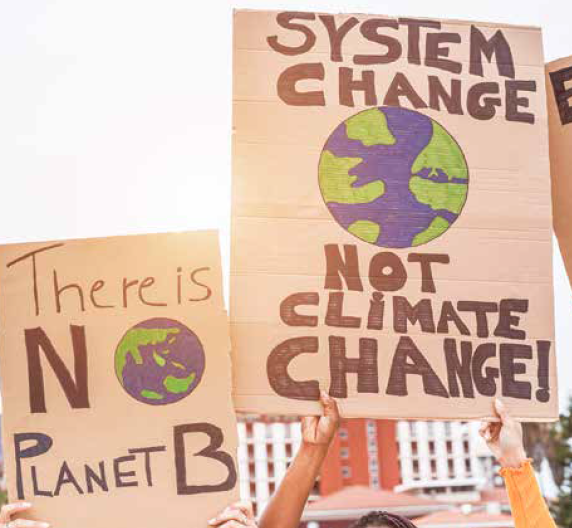EXCERPT | Humanity’s Grand Design Assignment: 5 Big Things to Save Life as we Know It
Editor’s Note: We’re excited to share an excerpt of the article titled “Humanity’s Grand Design Assignment: 5 Big Things to Save Life as We Know It”, written by ILFI’s founder and current board member Jason F. McLennan. You can read the full article, as well as McLennan Design’s quarterly magazine, Love + Regeneration, here.
Article by Jason F. McLennan, with Kristina Avramovic Oldani
It’s time we evolved. Literally evolved. ‘Punctuated equilibrium’ is a biological concept which describes a period of rapid evolution brought on by crisis or a quickly changing environment. The process of punctuated equilibrium leads to a new formation: cladogenesis — an evolutionary divergence. As a metaphor, we are in a moment of punctuated equilibrium and in need of a divergence from old ways of thinking that are no longer serving us or the planet of which we are part.

I want to acknowledge here that the ‘migration’ required of us is daunting. The enormity and comprehension of the change needed is overwhelming. And the heaviness of the pain and suffering running rampant across the earth and all its life including us is horribly depressing, at times paralyzingly so. But the antidote to this collectively felt anxiety and depression is acting with love.
To this end, this article examines five big things that we can and must do on behalf of the planet we live on to halt, then begin to reverse, and eventually regenerate vitality on earth, including in our societies. This list is by no means a comprehensive accounting of all that needs to be done to heal the planet, but by addressing these five big things we will accomplish a massive sea change for the better. This is the movement’s call to humanity. This is our big assignment.
First, and as quickly as possible, we need to decarbonize everything. We need to end the fossil fuel era in this decade and stop extracting and burning fossil fuels immediately.
While the concentration of carbon dioxide in the atmosphere has fluctuated over time, prior to the Industrial Revolution it held around 280 parts per million (ppm). Safe concentrations of carbon dioxide are below 350 ppm. We passed that threshold in 1988 and have now hit around 416 ppm. This increase is warming our atmosphere dangerously, with horrific results. Rising sea levels are displacing thousands across the world and threaten the homes and livelihoods of millions more. Species are failing to adapt to warmer temperatures, especially in the ocean, and we’re experiencing massive extinctions. Weather events are becoming more frequent and severe, claiming lives and causing significant and enormously expensive damage. As climate action organization 350.org announces succinctly, “It’s warming. It’s us. We’re sure. It’s bad.”
But they go on: “We can fix it.” Drawing down our carbon emissions to zero is the most urgently needed action to slow, then stop, the acceleration of climate change and eventually begin to heal and regenerate life on earth.
To this end, the first step is to transition to the full electrification of everything. The good news is that we already have viable and, in many cases, superior alternatives to all fossil fuel burning conveniences: electric cars, renewable energy that is cost effective, batteries, LED lights, heat pump-based HVAC systems, and induction stoves. We have all the technologies and systems we need now to decarbonize. All we need is the will to do so on a global scale.

At an individual level, we need to stop purchasing internal combustion vehicles. No one should ever buy one again. We need to de-couple from natural gas and upgrade everything to electric based systems. We need to disentangle our lives from the extraction, sale, and burning of fossil fuels in our world simply by not buying the technology that makes use of them. As demand for electric alternatives has risen, so has availability, and now we’re seeing costs decline due to the uptick in adoption. We’re out of excuses to buy fossil fuel burning technology. Period.
At local levels, we need to demand building and transportation policies that not only reward good choices, but actively phase out fuel burning technology by banning all combustion. Berkeley, California was the first city to ban natural gas appliances in new construction in the summer of 2019 and more than twenty cities quickly followed suit. Others, like Brookline, Massachusetts, have banned new gas hook-ups city-wide. Such building code amendments are critical to reflecting the urgency of climate change and the significant contribution of domestic natural gas use to overall carbon emissions. Development largely is governed at a municipal level and it is therefore critical that local building codes catch up to the urgency of our need to decarbonize.
In the various communities to which we belong—work, faith, educational, and municipal—we need to push leadership to entirely divest from fossil fuels. Just recently, over 40 institutions of faith spanning 14 countries came together to divest from fossil fuels, the largest ever joint divestment from the global faith community. Given the pandemic’s effects on the economy, 350.org applauds this collaborative effort’s critical timing: “This is a clear signal to the rest of the world that any future investments or stimulus funds must reject fossil fuels and provide long-term structural emissions reductions. The solutions to the economic crisis are the solutions to the climate crisis. It’s high time for governments to accelerate the transition needed towards a 100% renewable energy future. Any financial intervention must put people and their livelihoods at its core.” While amazing models like this are heartening, only a rapid and collaborated divestment movement will have the intended effects.

We need corporations to make concretized, quantifiable, and scientifically backed carbon reduction pledges and follow through on them. We’re seeing promising trends: 23% of Fortune 500 companies now have solid carbon reduction plans that disclose their emissions, set ambitious reduction targets, all on more aggressive timelines. In 2019, Amazon adopted a climate pledge that aims to achieve net-zero carbon across the business by 2040, ten years ahead of the Paris Agreement. It further created a $100 million dollar conservation and restoration fund. Early in 2020, Microsoft went a step further by committing to be carbon negative by 2030, with a $1 billion climate innovation fund. Apple committed to be 100 percent carbon neutral for its supply chain and products by 2030. They are already carbon neutral for corporate emissions worldwide, but the company plans to bring its entire carbon footprint to net zero 20 years sooner than IPCC targets. These commitments have resulted in Apple shrinking its carbon footprint by 35% since 2015, despite its continued growth. This kind of leadership is required across the transportation, service, and manufacturing industries to enact the rapid and comprehensive decarbonization needed.
At the governmental level, we need laws to reflect the climate crisis and the unviability of continuing to burn fossil fuels. We need funding, particularly in this moment, to support a future powered by renewables, with investments in technological advancements and job creation toward a living future. Germany just made a bold move by requiring all gas stations add electric vehicle charging capabilities. Policies like this are urgently needed to push us at the national level toward a comprehensive adoption of electrification.
Taken together, the effects of decarbonization will be monumental, and not just as action against climate change. Already, the price of utility scale solar energy is cheaper than that of fossil fuels, spurring rapid adoption of the switch toward renewables. Even though initial costs of solar are higher for the consumer, at an average cost of between 3 cents and 6 cents per kilowatt-hour, solar achieves cost parity with fossil fuels fairly quickly, which cost 5 – 17 cents per kilowatt-hour.
Improvements to air quality have been made apparent in the relatively brief amount of time since the COVID-19 pandemic erupted. Lockdown efforts in some places, like Jalandhar, India in the northern Punjab state, have resulted in clear skies and Himalayan views obscured for over 30 years by heavy air pollution. As a global community, we can demand such views, such access to clean air. That we’ve gotten a taste of what a world with fewer fossil fuels looks like bodes well for this migration.
Taken together, the effects of
decarbonization will be
monumental, and not
just as action against
climate change.
An end to the fossil fuel era promises an end to the particular evils and corruption intricately woven into the politics of energy. “The Department of Defense is the world’s largest institutional user of petroleum and correspondingly, the single largest producer of greenhouse gas emissions in the world,” writes Boston University Professor of Political Science Neta Crawford in a recent white paper entitled “Pentagon Fuel Use, Climate Change, and the Costs of War.” This consumption is in an antagonistic relationship to the military’s interest in creating energy stability by securing oil from regions of the world embroiled in conflict. An entire weapons and transportation industry has been built around our need for energy security, and this industry is economically fueled by conflict. The United States has been in an ongoing state of war since 2001, we’ve had only a few years of peace since the turn of the twentieth century. And while the Pentagon officially recognizes and understands the threat of climate change on national security, they do not officially concede their role in perpetuating the corrupt and enormously harmful military industrial complex by way of engaging in this relationship. “The US military has an opportunity to reduce the risks associated with climate change — and the security threats associated with climate change — by reducing their role in creating greenhouse gas emissions,” Crawford states simply.

And last—though certainly not least—our waters will regain dramatic health should we complete this transition. The horribly destructive practices of fracking and other modes of mining and drilling for oil and coal, dump chemicals and unwanted quantities of rock and soil in waterways. Oil spills have horrific effects on marine life and have created massive economic hardship in regions that rely on the sea for their livelihoods. Increasingly, these side effects are factored into the “true costs” of fossil fuel consumption, and rightly so. Without these kinds of failures and unintended, but very possible, even probable outcomes, renewable energy’s true costs are better reflected in the sticker price while the technology is far from perfect, improvements are trending toward elegant, comprehensively beneficial solutions to our energy needs.
The end of the fossil fuel era promises a cleaner, quieter, more peaceful, healthier world with air quality that surpasses any experienced in the past two hundred years. All that is needed is the collective will to change.


